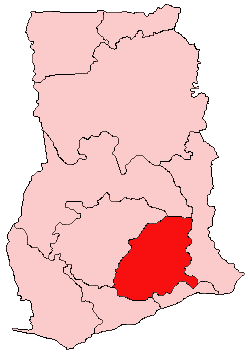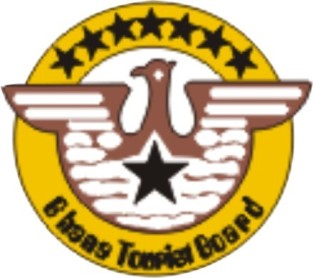Related Research Articles

Cape Coast is a city, fishing port, and the capital of Cape Coast Metropolitan District and Central Region of Ghana. It is one of the country's most historic cities, a World Heritage Site, home to the Cape Coast Castle, with the Gulf of Guinea situated to its south. According to the 2010 census, Cape Coast had a settlement population of 169,894 people. The language of the people of Cape Coast is Fante.

The Bight of Benin or Bay of Benin is a bight in the Gulf of Guinea area on the western African coast that derives its name from the historical Kingdom of Benin.

The Royal African Company (RAC) was an English trading company established in 1660 by the House of Stuart and City of London merchants to trade along the West African coast. It was overseen by the Duke of York, the brother of Charles II of England; the RAC was founded after Charles II ascended to the English throne in the 1660 Stuart Restoration, and he granted it a monopoly on all English trade with Africa. While the company's original purpose was to trade for gold in the Gambia River, as Prince Rupert of the Rhine had identified gold deposits in the region during the Interregnum, the RAC quickly began trading in slaves, which became its largest commodity.

Elmina Castle was erected by the Portuguese in 1482 as Castelo de São Jorge da Mina, also known as Castelo da Mina or simply Mina, in present-day Elmina, Ghana, formerly the Gold Coast. It was the first trading post built on the Gulf of Guinea, and the oldest European building in existence south of the Sahara.

Cape Coast Castle is one of about forty "slave castles", or large commercial forts, built on the Gold Coast of West Africa by European traders. It was originally a Portuguese "feitoria" or trading post, established in 1555, which they named Cabo Corso.

Elmina, also known as Edina by the local Fante, is a town and the capital of the Komenda/Edina/Eguafo/Abirem District on the south coast of Ghana in the Central Region, situated on a bay on the Atlantic Ocean, 12 kilometres west of Cape Coast. Elmina was the first European settlement in West Africa and it has a population of 33,576 people.

Kakum National Park, located in the coastal environs of the Central Region of Ghana, covers an area of 375 square kilometres (145 sq mi). Established in 1931 as a reserve, it was gazetted as a national park only in 1992 after an initial survey of avifauna was conducted. The area is covered with tropical forest. The uniqueness of this park lies in the fact that it was established at the initiative of the local people and not by the State Department of wildlife who are responsible for wildlife preservation in Ghana. It is one of only 3 locations in Africa with a canopy walkway, which is 350 metres (1,150 ft) long and connects seven tree tops which provides access to the forest.

Gqeberha, previously named Port Elizabeth, and colloquially referred to as P.E., is a major seaport and the most populous city in the Eastern Cape province of South Africa. It is the seat of the Nelson Mandela Bay Metropolitan Municipality, South Africa's second-smallest metropolitan municipality by area. It is the sixth-most populous city in South Africa and is the cultural, economic and financial hub of the Eastern Cape.

The Central Region is one of the sixteen administrative regions of Ghana. It is bordered by Ashanti and Eastern regions to the north, Western region to the west, Greater Accra region to the east, and to the south by the Gulf of Guinea. The Central Region is renowned for its many elite high schools and an economy based on an abundance of industrial minerals and tourism. The Central region boasts of many tourist attractions such as castles, forts and beaches dotted along the region's coastline.

A slave market is a place where slaves are bought and sold. These markets became a key phenomenon in the history of slavery.

Kwahu refers to an area and group of people that live in Ghana and are part of the Twi-speaking Akan group. Their homeland has been dubbed Asaase Aban, or the Natural Fortress, in view of its position as the highest habitable elevation in the country. Kwahu lies in the Eastern Region of Ghana, on the west shore of Lake Volta. The Kwahus share the Eastern Region with their fellow Akans: the Akyem and Akuapem, as well as the Adangbe-Krobos. Among Kwahu lands, a significant migrant population work as traders, farm-hands, fisherfolk, and caretakers in the fertile waterfront 'melting pot' of Afram plains. These migrants are mostly from the Northern and Volta Regions, as well as, some indigenous Guans from the bordering Oti and Brong-Ahafo regions live in the Afram Plains area. Kwahus are traditionally known to be wealthy traders, owning a significant number of businesses and industries in Ghana.

The House of Slaves and its Door of No Return is a museum and memorial to the victims of the Atlantic slave trade on Gorée Island, 3 km off the coast of the city of Dakar, Senegal. Its museum, which was opened in 1962 and curated until Boubacar Joseph Ndiaye's death in 2009, is said to memorialise the final exit point of the slaves from Africa. While historians differ on how many African slaves were actually held in this building, as well as the relative importance of Gorée Island as a point on the Atlantic slave trade, visitors from Africa, Europe, and the Americas continue to make it an important place to remember the human toll of African slavery.
Articles related to Ghana include:
Genealogy tourism, sometimes called roots tourism, is a segment of the tourism market consisting of tourists who have ancestral connections to their holiday destination. These genealogy tourists travel to the land of their ancestors to reconnect with their past and "walk in the footsteps of their forefathers".

Tourism is an important economic sector for many countries in Africa. There are many countries that benefit heavily from tourism like Uganda, Algeria, Egypt, South Africa, Kenya, Morocco, Tunisia, Ghana and Tanzania. The touristic particularity of Africa lies in the wide variety of points of interest, diversity and multitudes of landscapes as well as the rich cultural heritage. Also, an ecotourist industry is present in some African countries.

The Ministry of Tourism, Arts & Culture (MoTAC) Ghana is the government ministry responsible for the development and promotion of tourism-related activities in the country.

Assin Manso is a town in the Central Region of Ghana. It is located 40 kilometers along the Cape Coast - Kumasi highway. The town is well known for the role it played as a slave market during the slave trade. It is also known for the Assin Manso Secondary School. The school is a second cycle institution.
Tourism in Ghana is regulated by the Ministry of Tourism of Ghana. This ministry is responsible for the development and promotion of tourism related activities in Ghana.
The Ghana Tourism Authority is a Ghanaian state agency under the Ministry of Tourism, Culture and Creative Arts responsible for the regulation of tourism in Ghana by marketing, promoting, licensing, classifying, researching and developing tourism facilities and services in the country. To know more about places you can visit, the visitghana website can be accessed for enquiries.

The Bono East region of Ghana is a new region carved out of the Brong Ahafo region. The capital of the new region is Techiman. This creation of this new region was in fulfillment of a promise made by the New Patriotic Party prior to the 2016 Ghana general election. Upon winning the elections, the President, Nana Akuffo Addo created the Ministry of Regional Reorganization to oversee policy formulation and implementation. In all six new regions are to be created from the existing ten regions of Ghana. The other regions are Bono, Western North, Ahafo, Savannah, North East, and Oti regions.
References
- 1 2 3 4 5 "Visit Ghana | Assin Manso Ancestral Slave River Site". Visit Ghana. Retrieved 2021-05-11.
- 1 2 3 4 Schramm, Katharina (January 2008). "Slave Route Projects: Tracing the Heritage of Slavery in Ghana". University of Bayreuth – via Research Gate.
- 1 2 Agyemang, Osei (2020-11-20). "Ghana's Ancestral Slave River Park Always Connects To Emotions: Journey Was Full Of Abuse…". Medium. Retrieved 2021-05-11.
- ↑ "Assin Manso Slave River | Beyond The Return" . Retrieved 2021-05-11.
- ↑ Lystad, Robert A. (February 1965). "A History of Ghana . W. E. F. Ward". American Anthropologist. 67 (1): 179. doi: 10.1525/aa.1965.67.1.02a00680 . ISSN 0002-7294.
- ↑ "Assin Manso Slave Market | About Ghana". ghana.peacefmonline.com. Retrieved 2021-05-11.
- 1 2 3 Sibeko, Alessandra Prentice, Siphiwe (2019-08-20). "Ghana cashes in on slave heritage tourism". Reuters. Retrieved 2021-05-11.
{{cite news}}: CS1 maint: multiple names: authors list (link)